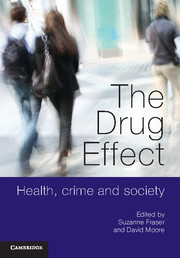Book contents
- Frontmatter
- Contents
- List of contributors
- Acknowledgements
- Introduction
- Part 1 Drug use as social and cultural practice
- Part 2 Drugs, health and the medicalisation of addiction
- Part 3 Drugs, crime and the law
- 9 Court-ordered treatment, neoliberalism and Homo economicus
- 10 Cannabis in cultural and legal limbo
- 11 Drugs, crime and the law in Australia
- 12 Reconceptualising harm reduction in prisons
- 13 Possessed
- Index
- References
12 - Reconceptualising harm reduction in prisons
from Part 3 - Drugs, crime and the law
- Frontmatter
- Contents
- List of contributors
- Acknowledgements
- Introduction
- Part 1 Drug use as social and cultural practice
- Part 2 Drugs, health and the medicalisation of addiction
- Part 3 Drugs, crime and the law
- 9 Court-ordered treatment, neoliberalism and Homo economicus
- 10 Cannabis in cultural and legal limbo
- 11 Drugs, crime and the law in Australia
- 12 Reconceptualising harm reduction in prisons
- 13 Possessed
- Index
- References
Summary
Harm reduction, as a framework to reduce drug-related harm, has a long history in some countries. However, it was not until the arrival of HIV in the 1980s that harm reduction began to be re-emphasised in drug policy debates throughout the world. Harm reduction was increasingly framed in public health and social justice terms. As part of the wider public health movement to protect individual and population health, the prevention of HIV transmission and drug-related deaths through harm reduction techniques became a high priority. Harm reduction initiatives, such as needle exchange and drug consumption rooms, represented major transformations in dealing with problem drug users. Stimson points to the globalisation of harm reduction and its ‘indispensable place in the way in which societies can respond to drugs problems’. In Europe, joint strategies and action plans were developed to tackle problematic drug use and public health issues. A clear convergence towards harm reduction occurred as it became more mainstreamed and accepted. This consensus also has been achieved in other countries.
The mainstreaming of harm reduction has not been successful in some settings. A good example is the prison environment where there has been a history of resistance to its implementation. The policies in prisons in many countries have failed to fully embrace the concept of ‘harm reduction’ and the public health agenda that operate successfully in the community (see ‘Definition of harm reduction’). Within analyses of drug and penal policy, the complex relationship between medical and penal forms of control is a potent theme. The drug user is the subject of various forms of control and regulation, including medical, legal and moral, which are often in conflict with each other. The discourses of rehabilitation, welfare and harm reduction frequently clash with those of punishment, security and justice, and these conflicts and contradictions manifest themselves most acutely within the prison environment. This has had a significant effect on the historical development of harm reduction in prisons.
- Type
- Chapter
- Information
- The Drug EffectHealth, Crime and Society, pp. 209 - 224Publisher: Cambridge University PressPrint publication year: 2011
References
- 3
- Cited by



